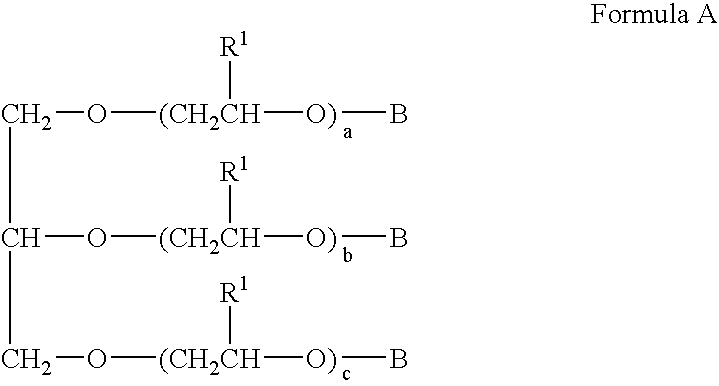Biocidal compositions
a technology of compositions and biocide, applied in the field of biocidal compositions, can solve the problems of obpa solution routine exposure to extreme heat and cold, reduce shipping costs and storage costs, and none of the results have been entirely satisfactory, and achieve the effect of low voc values
- Summary
- Abstract
- Description
- Claims
- Application Information
AI Technical Summary
Benefits of technology
Problems solved by technology
Method used
Image
Examples
example 1
[0051]A number of materials are subjected to the following procedure to determine which, if any, might be suitable as co-solvents for OBPA and diisodecyl phthalate.
[0052]In each procedure, a mixture is prepared by combining 5.0 g of 10, 10′-oxybisphenoxarsine with 45.0 g of diisodecyl phthalate and 50 g of a material of interest. The mixture is heated to a temperature in the range of 90-100° C. with stirring until it appears to be a single, clear liquid phase. The mixture is permitted to cool to room temperature (in the range of 22-25° C.) and samples of the cooled mixture are taken and stored for five days at room temperature, in a refrigerator for five days at 4° C. and in a freezer for five days at −13° C. The samples are observed for any evidence of precipitation, such as settling or clouding. Data is presented in Table I.
[0053]
TABLE IPhysical Stability of 10,10′-oxybisphenoxarsine in Various SolutionsMaterial ofOf Invention orRoomInterestFor ComparisonTemperatureRefrigeratorFre...
example 2
[0055]The procedure described above in Example 1 is performed with ethoxylated castor oils as the respective materials of interest. The ethoxylated castor oils are commercially supplied by Rhodia of Cranbury, N.J. under the trade names Alkamus EL-620 and Alkamus EL-985 and are specified as a PEG-30 derivative of castor oil and a PEG-200 derivative of castor oil, respectively. Data is observed and recorded below in Table II.
[0056]
TABLE II10,10′-oxybisphenoxarsine, Diisodecyl Phthalateand Ethoxylated Castor OilOf InventionMaterial ofor ForRoomInterestComparisonTemperatureRefrigeratorFreezerAlkamuls EL-InventionCLEARCLEARCLEAR620(a PEG-30derivative ofCastor Oil)Alkamuls EL-ComparisonPrecipitateNotNot985 (a PEG-200ApplicableApplicablederivative ofCastor Oil)
[0057]The data in Table II indicates that a solution consisting of 5 wt % 10, 1′-oxybisphenarsazine, 45 wt % diisodecyl phthalate and 50 wt % ethoxylated castor oil derived from a polyethylene glycol of nominally about 30 ethylene ox...
example 3
[0058]VOC values of a castor oil solution of the invention and of two previously known commercial solutions are determined using the following procedure. A sample of the solution is accurately weighed on an analytical balance scale. The sample is maintained in an oven at 105° C., cooled to room temperature and weighed on the analytical balance. The specific gravity of the solution of interest is measured. The difference in weight is reported as VOC on the basis of one liter of the solution of interest. The data is shown below in Table III.
[0059]
TABLE IIIVOC for Solutions including Biocide and PlasticizerDiisodecylOf InventionOBPAPhthalateor ForBiocidePlasticizerSolventObservedComparison(wt %)(wt %)(wt %)VOC (g / l)Castor OilInvention5.045Castor Oil 0Solution50BenzylComparison5.075Benzyl215AlcoholAlcoholSolution20IsodecylComparison5.075Isodecyl204AlcoholAlcoholSolution20
[0060]The data in Table III indicates that a castor oil solution of the invention has very low VOC.
PUM
| Property | Measurement | Unit |
|---|---|---|
| Angle | aaaaa | aaaaa |
| Density | aaaaa | aaaaa |
| Substance count | aaaaa | aaaaa |
Abstract
Description
Claims
Application Information
 Login to View More
Login to View More - R&D
- Intellectual Property
- Life Sciences
- Materials
- Tech Scout
- Unparalleled Data Quality
- Higher Quality Content
- 60% Fewer Hallucinations
Browse by: Latest US Patents, China's latest patents, Technical Efficacy Thesaurus, Application Domain, Technology Topic, Popular Technical Reports.
© 2025 PatSnap. All rights reserved.Legal|Privacy policy|Modern Slavery Act Transparency Statement|Sitemap|About US| Contact US: help@patsnap.com



